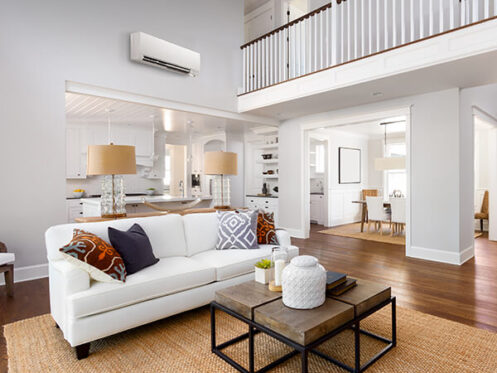Ductless mini splits have been hyped due to their various benefits over regular HVAC systems. Mini-split systems have an outdoor unit connected to the indoor units with a small conduit. They do not have ductwork. This lack of complex components makes installing them easier than central air conditioners, and you can use them in renovated or old buildings. One advantage that makes the mini splits stand out is their energy efficiency. But what makes them more efficient than other HVAC systems?
1. Lack of Ducts
Regular HVAC systems rely on ducts to move conditioned air to the rooms. More than 30% of the total heat is lost through ductwork. Pinholes and cracks allow heated or cooled air to leak out of the ducts. The losses are higher if the ductwork is in unconditioned spaces, such as the attic. Ductless mini splits do not have these losses. They deliver conditioned air into the room, making them more efficient than high-efficiency forced-air systems.
2. Heat Pump Technology
Heat pumps transfer heat from one area to another rather than generating it through combustion or resistance heating. The benefit of this reversed technology is it can be used to cool and heat. Mini splits mostly use air-source heat pumps. In heating mode, it extracts heat from ambient air and pumps it indoors. In cooling mode, the process is reversed. Since this system does not require electricity or fuel to cool or heat, it reduces reliance on energy sources. The only electrical power needed is in the transfer of heat.
3. Zoned Heating and Cooling
Zoning is the division of the building into different parts (zones). Traditional systems condition the whole building as one unit. Ductless mini splits focus on specific zones. The occupied spaces receive conditioned air, and empty rooms remain at energy-conserving temperatures. The occupants can also set the temperatures to their preference. This prevents overheating or overcooling, resulting in energy conservation.
4. Variable Speed Compressor
The compressor pressurizes and circulates the refrigerant. Regular HVAC systems have fixed-speed compressors that operate at a constant speed regardless of the heat demand. Variable speed compressors can adjust their speeds based on temperature needs. When the heating or cooling demand is low, the compressor works at a lower speed. At this pace, the system consumes less energy. It will also prevent the need for frequent short cycles, which contribute to energy inefficiency.
Regular coolers often lead to very dry air, and you need a humidifier to add moisture, which adds to energy use. When working at low speeds, the variable speed compressors help improve the dehumidification abilities of the system. They can run for long periods at low speeds, removing excess moisture from the air while keeping the temperature at acceptable levels. There may be no need for humidifiers.
5. Inverter Technology
Mini-split systems are designed with inverter technology. They have sensors that continually monitor temperature and adjust the compressor’s speed. This technology allows the system to heat or cool a room rapidly, reducing the time the system operates at high power levels. This leads to reduced energy consumption.
6. Smart Thermostat Integration
Mini-split systems are equipped with smart thermostats that enable homeowners to control their systems remotely. This is done on mobile apps or web interfaces. They can adjust temperature settings, monitor energy usage, and change the system’s operation regardless of the distance. This real-time adjustment based on occupancy and weather conditions will help reduce energy consumption.
A homeowner can create custom schedules for different zones based on daily routines. The smart thermostats can also sense a room’s occupation using geofencing technology. If no occupants are detected, the system automatically adjusts to an energy-saving mode, reducing energy consumption.
Some thermostats can integrate with weather forecast data. They can adjust settings depending on upcoming weather. If a heatwave or a cold spell is expected, the thermostat will signal the system to precool or preheat the room. This will reduce the workload during peak temperature periods.
Mini-split systems have a high seasonal energy efficiency ratio. This means they provide more cooling or heating output for each unit of electrical energy consumed. If your current HVAC system is on its last feet, consider installing ductless mini splits to save on energy bills. At Simply Mechanical, we are committed to providing heating and cooling services in Littleton, CO. We are specialists in system repair, maintenance, and new installation services. Our company is an authorized American Standard Dealer, servicing different HVAC models and makes. Contact Simply Mechanical today, and get services tailored to your needs.


